Abstract
1. Pharmacokinetics and pharmacodynamics of R- and S-verapamil and R- and S-norverapamil were studied at steady state following administration of 180 mg verapamil delivered by a controlled-release gastrointestinal therapeutic system (COER-verapamil). 2. Of the 30 young (19 to 43 years) and 30 elderly subjects (65 to 80 years) enrolled, approximately half of each age group were women; all subjects were healthy and none were smokers. 3. Mean R- and S-verapamil and R- and S-norverapamil Cmax, Cmin, and AUC values for elderly subjects were 1.2 to 2.2 times greater than those for young subjects; these differences were statistically significant at P < 0.05. Median tmax values for young and elderly subjects were not significantly different for any enantiomer. The mean half-life values of R- and S-verapamil for elderly subjects were approximately 20 h compared with approximately 13 h for young subjects, respectively. The mean half-life values of R- and S-norverapamil for elderly subjects were approximately 31 h and 20 h, respectively, compared with approximately 19 h and 21 h for young subjects, respectively. 4. In both age groups, the mean plasma verapamil concentrations of each enantiomer were higher for women than for men at all time points. 5. Mean arterial pressure (MAP) had a significant correlation to R- (r2 = 0.86) and S-verapamil (r2 = 0.87) concentration values that was not influenced by either gender or age of the patient. Change in PR-interval also had a significant correlation to R- and S-verapamil concentration values. However, the sensitivity of the response to changes in R- and S-verapamil concentration values in elderly subjects was about 1/5 of that in younger subjects.
Full text
PDF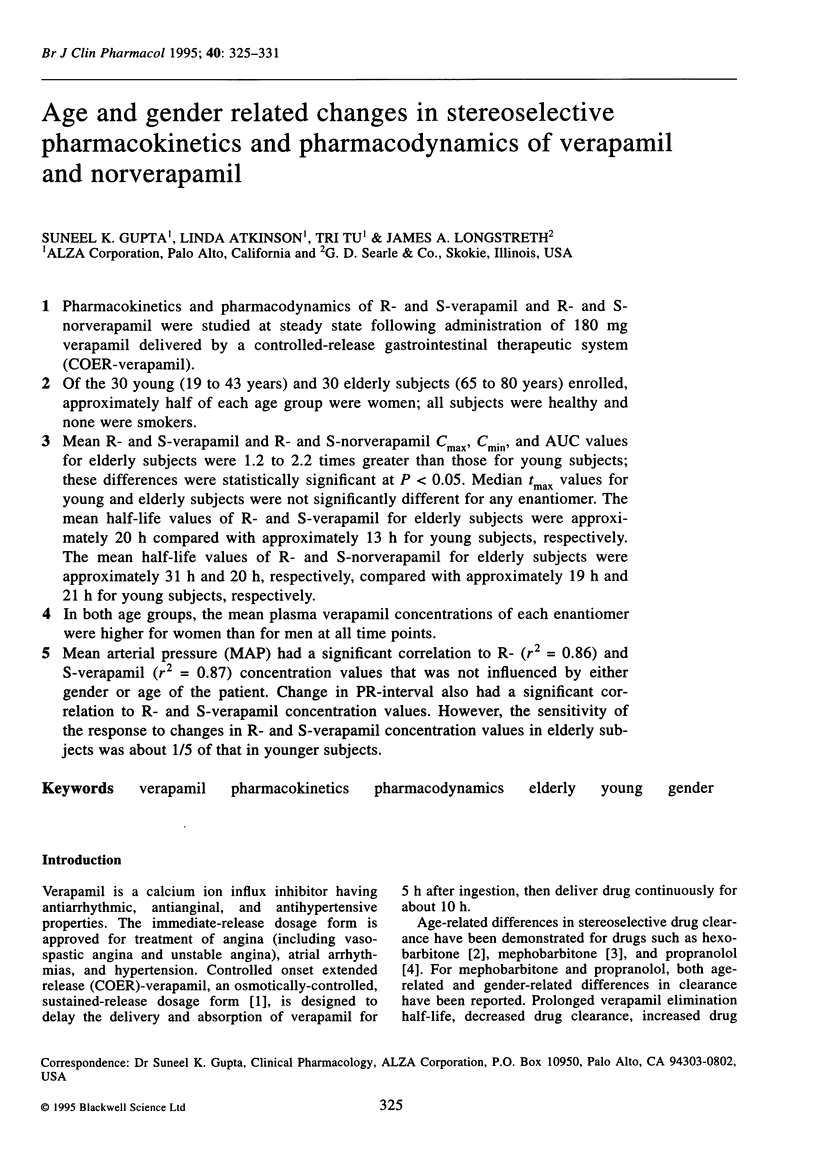
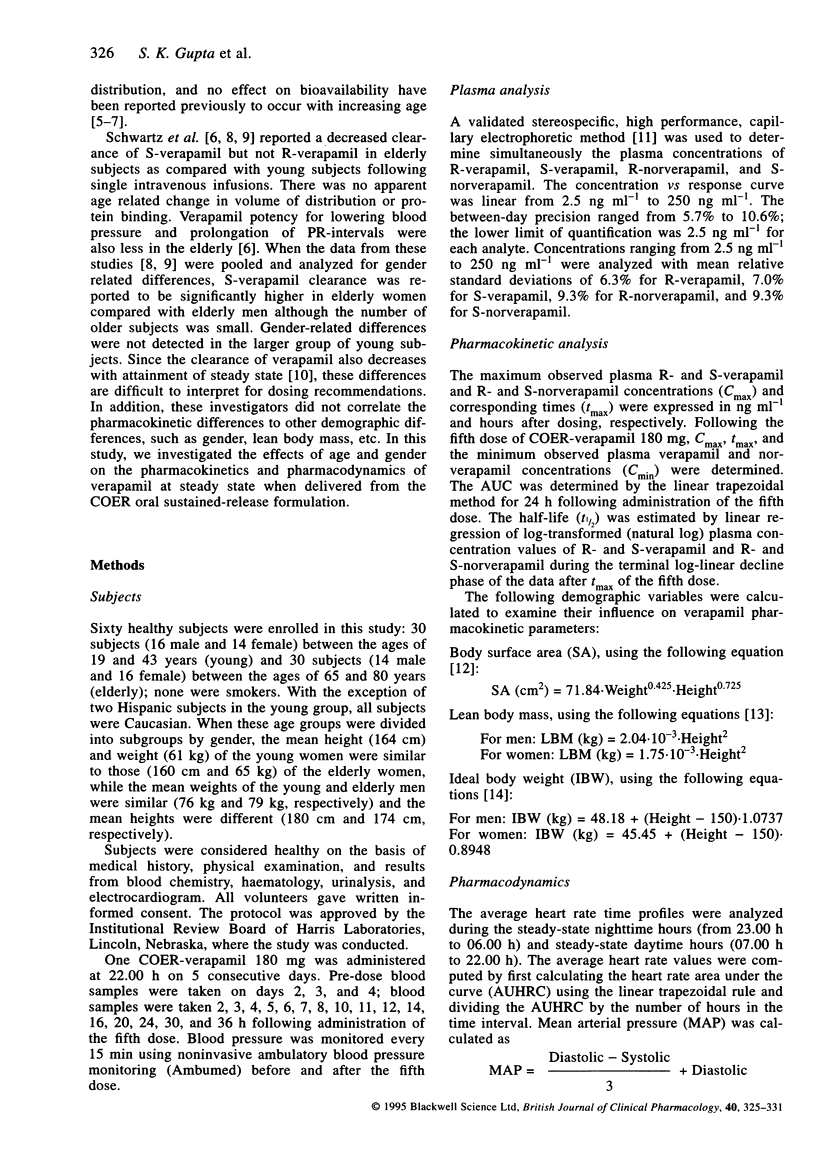
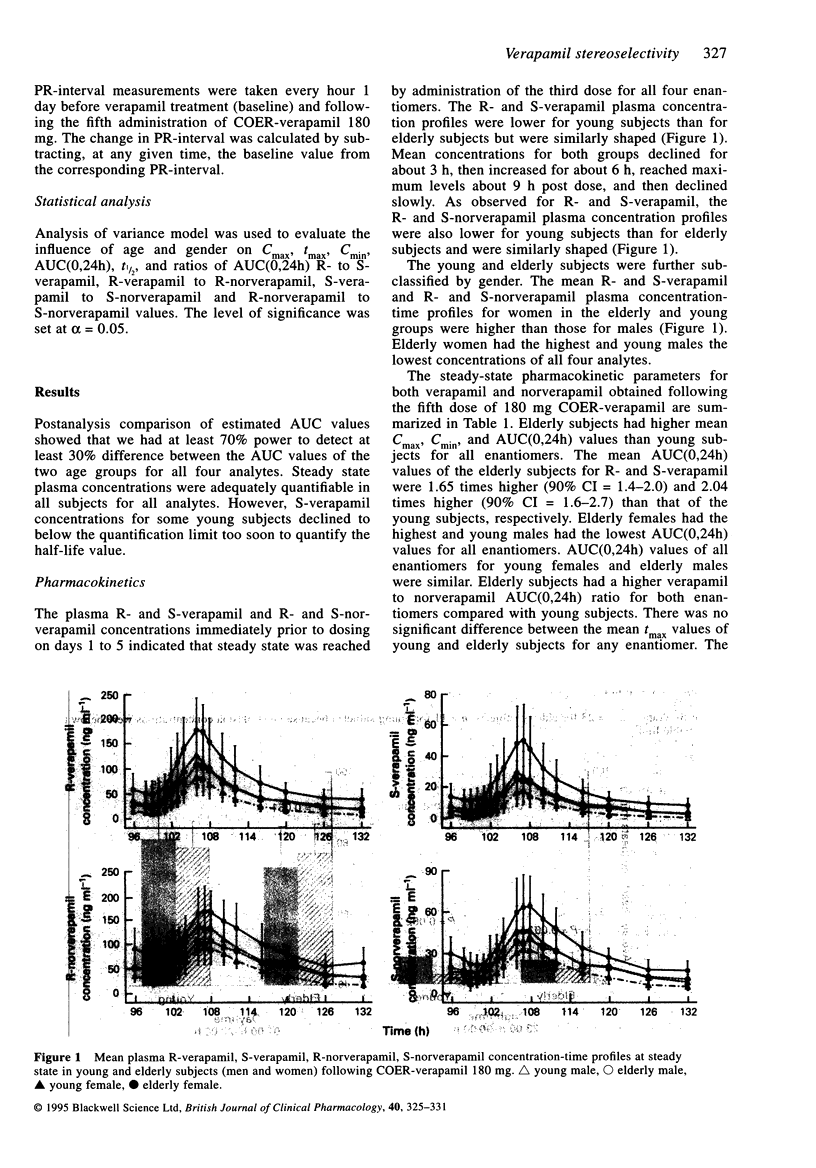
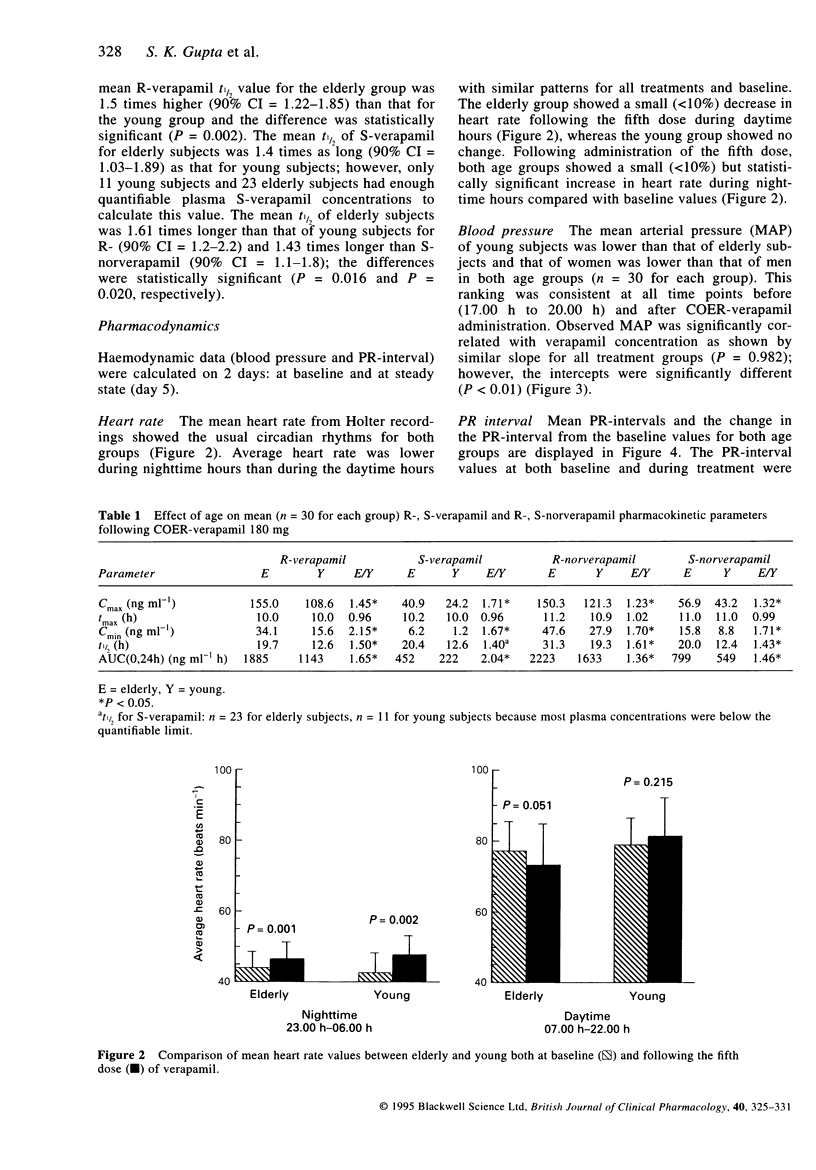
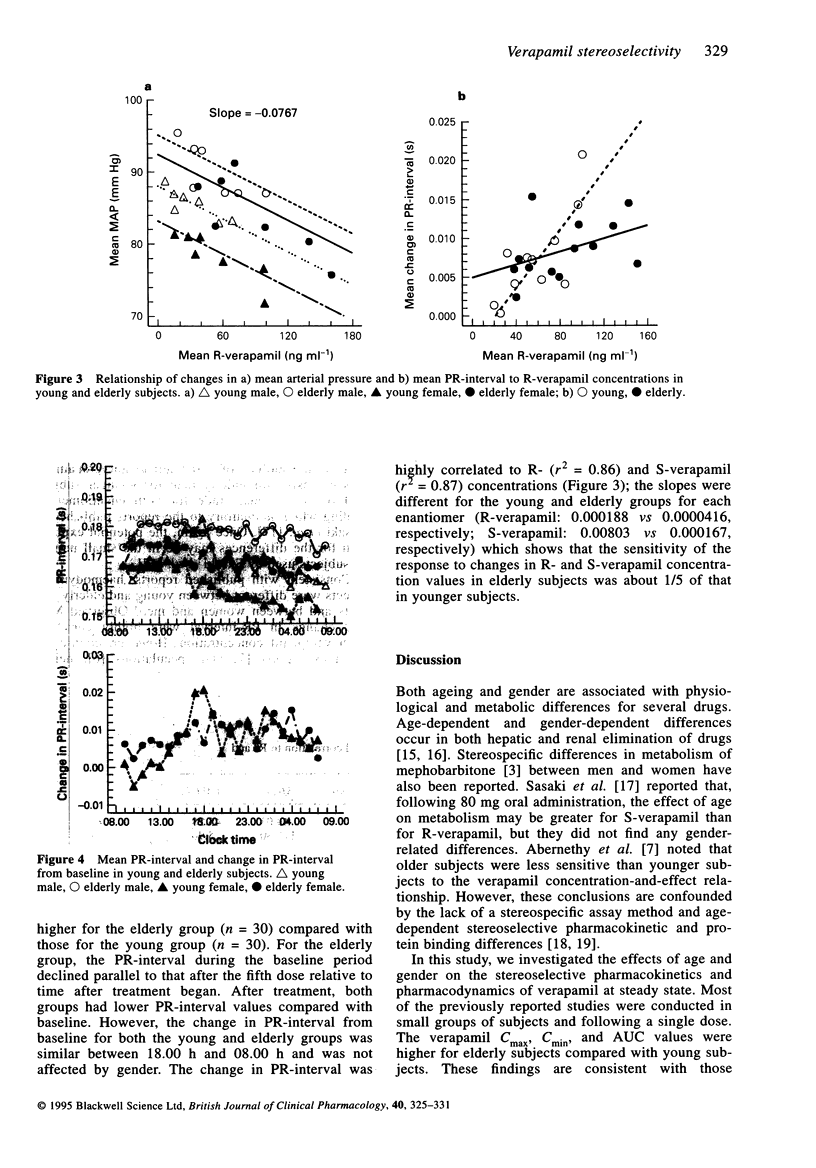
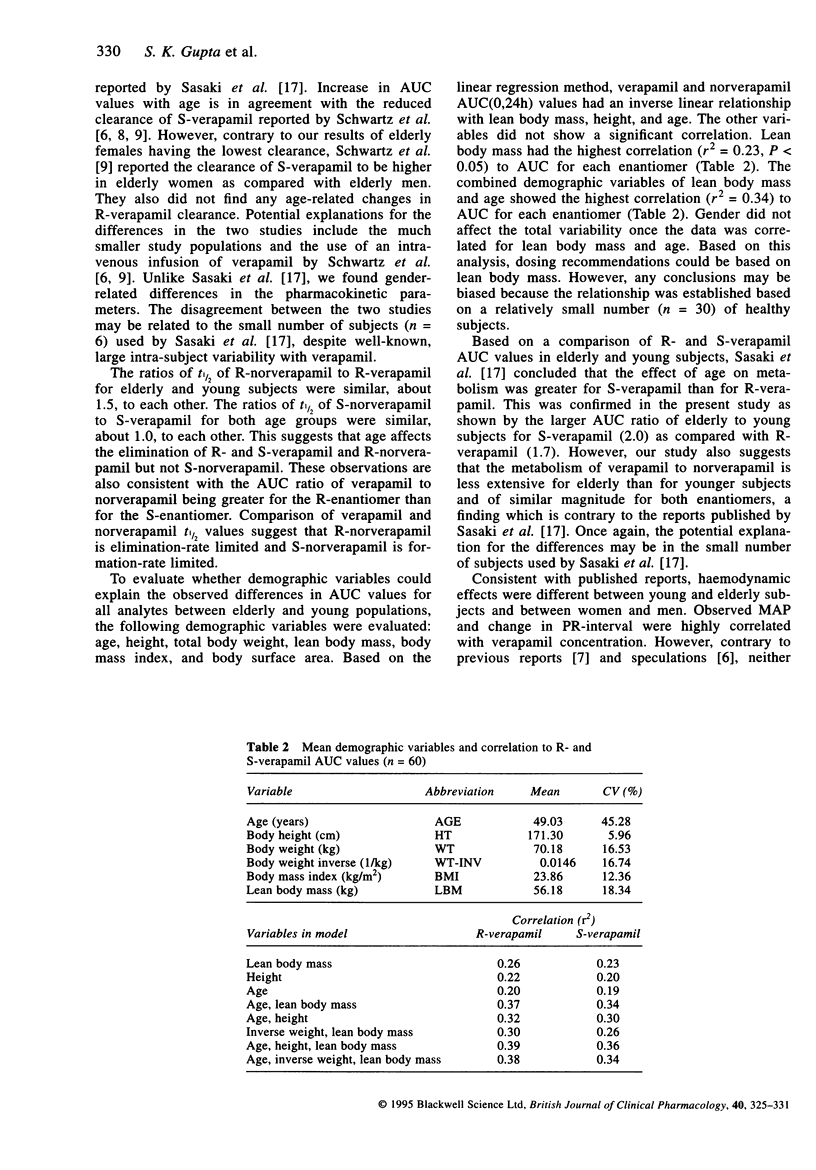

Selected References
These references are in PubMed. This may not be the complete list of references from this article.
- Abernethy D. R., Schwartz J. B., Todd E. L., Luchi R., Snow E. Verapamil pharmacodynamics and disposition in young and elderly hypertensive patients. Altered electrocardiographic and hypotensive responses. Ann Intern Med. 1986 Sep;105(3):329–336. doi: 10.7326/0003-4819-105-3-329. [DOI] [PubMed] [Google Scholar]
- Chandler M. H., Scott S. R., Blouin R. A. Age-associated stereoselective alterations in hexobarbital metabolism. Clin Pharmacol Ther. 1988 Apr;43(4):436–441. doi: 10.1038/clpt.1988.55. [DOI] [PubMed] [Google Scholar]
- Dethy J. M., De Broux S., Lesne M., Longstreth J., Gilbert P. Stereoselective determination of verapamil and norverapamil by capillary electrophoresis. J Chromatogr B Biomed Appl. 1994 Mar 18;654(1):121–127. doi: 10.1016/0378-4347(93)e0455-y. [DOI] [PubMed] [Google Scholar]
- Eichelbaum M., Mikus G., Vogelgesang B. Pharmacokinetics of (+)-, (-)- and (+/-)-verapamil after intravenous administration. Br J Clin Pharmacol. 1984 Apr;17(4):453–458. doi: 10.1111/j.1365-2125.1984.tb02371.x. [DOI] [PMC free article] [PubMed] [Google Scholar]
- Gilmore D. A., Gal J., Gerber J. G., Nies A. S. Age and gender influence the stereoselective pharmacokinetics of propranolol. J Pharmacol Exp Ther. 1992 Jun;261(3):1181–1186. [PubMed] [Google Scholar]
- Hooper W. D., Qing M. S. The influence of age and gender on the stereoselective metabolism and pharmacokinetics of mephobarbital in humans. Clin Pharmacol Ther. 1990 Dec;48(6):633–640. doi: 10.1038/clpt.1990.207. [DOI] [PubMed] [Google Scholar]
- Robinson J. D., Lupkiewicz S. M., Palenik L., Lopez L. M., Ariet M. Determination of ideal body weight for drug dosage calculations. Am J Hosp Pharm. 1983 Jun;40(6):1016–1019. [PubMed] [Google Scholar]
- Sasaki M., Tateishi T., Ebihara A. The effects of age and gender on the stereoselective pharmacokinetics of verapamil. Clin Pharmacol Ther. 1993 Sep;54(3):278–285. doi: 10.1038/clpt.1993.148. [DOI] [PubMed] [Google Scholar]
- Schmucker D. L. Aging and drug disposition: an update. Pharmacol Rev. 1985 Jun;37(2):133–148. [PubMed] [Google Scholar]
- Schmucker D. L., Woodhouse K. W., Wang R. K., Wynne H., James O. F., McManus M., Kremers P. Effects of age and gender on in vitro properties of human liver microsomal monooxygenases. Clin Pharmacol Ther. 1990 Oct;48(4):365–374. doi: 10.1038/clpt.1990.164. [DOI] [PubMed] [Google Scholar]
- Schwartz J. B. Aging alters verapamil elimination and dynamics: single dose and steady-state responses. J Pharmacol Exp Ther. 1990 Oct;255(1):364–373. [PubMed] [Google Scholar]
- Schwartz J. B., Capili H., Daugherty J. Aging of women alters S-verapamil pharmacokinetics and pharmacodynamics. Clin Pharmacol Ther. 1994 May;55(5):509–517. doi: 10.1038/clpt.1994.64. [DOI] [PubMed] [Google Scholar]
- Schwartz J. B., Capili H., Wainer I. W. Verapamil stereoisomers during racemic verapamil administration: effects of aging and comparisons to administration of individual stereoisomers. Clin Pharmacol Ther. 1994 Oct;56(4):368–376. doi: 10.1038/clpt.1994.151. [DOI] [PubMed] [Google Scholar]
- Schwartz J. B., Troconiz I. F., Verotta D., Liu S., Capili H. Aging effects on stereoselective pharmacokinetics and pharmacodynamics of verapamil. J Pharmacol Exp Ther. 1993 May;265(2):690–698. [PubMed] [Google Scholar]
- Shand D. G., Hammill S. C., Aanonsen L., Pritchett E. L. Reduced verapamil clearance during long-term oral administration. Clin Pharmacol Ther. 1981 Nov;30(5):701–706. doi: 10.1038/clpt.1981.223. [DOI] [PubMed] [Google Scholar]
- Vogelgesang B., Echizen H., Schmidt E., Eichelbaum M. Stereoselective first-pass metabolism of highly cleared drugs: studies of the bioavailability of L- and D-verapamil examined with a stable isotope technique. Br J Clin Pharmacol. 1984 Nov;18(5):733–740. doi: 10.1111/j.1365-2125.1984.tb02536.x. [DOI] [PMC free article] [PubMed] [Google Scholar]
- Woodcock B. G., Rietbrock I., Vöhringer H. F., Rietbrock N. Verapamil disposition in liver disease and intensive-care patients: kinetics, clearance, and apparent blood flow relationships. Clin Pharmacol Ther. 1981 Jan;29(1):27–34. doi: 10.1038/clpt.1981.5. [DOI] [PubMed] [Google Scholar]


